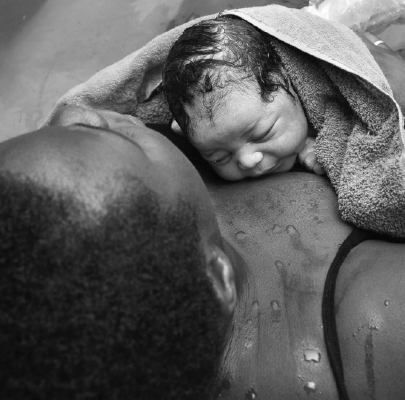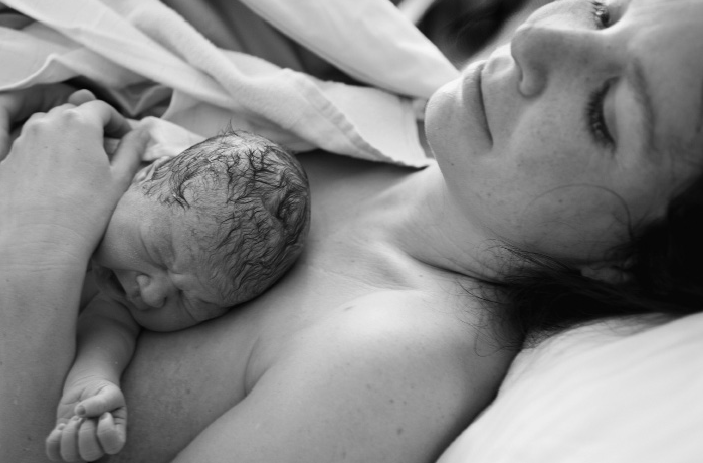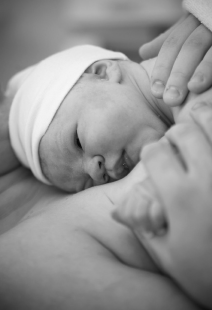Welcoming Your Baby
NOTE: This fact sheet pertains to full-term healthy babies, delivered vaginally or by C-section. Some or all of the information may be useful to other babies as well, but will depend on the individual situation.


Bringing You and Your Baby Together RIGHT After Birth
Birthing is a stressful process for both mother and baby. New research has shown that it is important to place a newborn directly on its mother’s chest – skin touching. This skin-to-skin contact is called Kangaroo Mother Care. Kangaroo Mother Care is now considered best medical practice in U.S. hospitals.
What is so good about Kangaroo Mother/skin-to-skin contact?
Putting the newborn directly onto your bare chest is the most natural place for baby to be following birth. This contact helps the newborn to:
- maintain body temperature
- stabilize its heart and breathing rates
- reduce crying
- feel your warmth and touch
- see your face and gaze into your eyes
- hear your voice up close
- reduce your stress
- increase your bonding and confidence
- jump-start your milk production
What about routine after-birth procedures?
In the past, most hospitals observed the infant, washed it and provided treatments immediately after delivery, while the mother waited for her infant. This separation leads to stress in both mother and baby.
With skin-to-skin care, nurses quickly wipe off the infant and assess its health (the Apgar score) before placing it on your chest. Diapering is optional. Routines such as bathing and dressing can wait until baby has finished the first feeding. Treatments such as eye drops, shots or blood work can be done while baby is on your chest.
What happens when my newborn is placed on my chest?
Most babies rest for several minutes once placed on mom’s chest. You should begin to stroke the infant’s back in one direction. During this time, your baby’s body is adjusting to the outside world. Then your baby will wiggle around, bobbing her head up and down. Your baby may suck on his hands or your skin. Finally, your baby will start to move across your chest, seeking your breasts.
How long will my baby stay on my chest?
If you intend to breastfeed, the infant should remain on your chest until your baby finishes the first feed.
If you choose to formula feed, your baby should still remain on your chest to allow for a few sucks before being removed. These first sucks stimulate the release of the hormone oxytocin, necessary to stop your blood loss following birth.
Kangaroo Care and breastfeeding
Studies have shown that breastfeeding right after birth leads to long-term breastfeeding success. A newborn baby has strong suckling reflexes that allow him to breastfeed without much help when placed close to his mother in the first hour after birth. This first feed helps baby learn the correct position of the jaw, mouth and tongue , important for exclusive breastfeeding. In addition, starting breastfeeding right after birth protects a baby from harmful bacteria, lowering the risk of early infections. When your baby suckles, your breastfeeding hormones are released to produce and “let down” milk, paving the way for strong mother-baby attachment.
How do I find out if my hospital practices Kangaroo Mother Care?
ASK when you complete your admission paperwork if this is routine practice. Find out what would prevent immediate skin-to-skin care so you will be prepared if other procedures are needed.
SPEAK UP. Let your doctor and the nursing staff know what your wishes are. You are entitled to receive best medical practice for yourself and your infant.

References:
Breastfeeding: The 1st Hour—Welcome Baby Softly. 2007. International Lactation Consultant Association.
Lauwers J, Swisher A. Counseling the Nursing Mother. 4th edition. Jones and Bartlett Publishers. Sudbury, MA.
ABM Clinical Protocol #5: Peripartum Breastfeeding Management for the Healthy Mother and Infant at Term Revision. 2008. BREASTFEEDING MEDICINE 3(2).
Resources:
Breastfeeding warm line: University of Nevada Cooperative Extension: 702–257-5583
Southern Nevada Breastfeeding Coalition
Mom's Special Gift is partially funded by USDA's Supplemental Nutrition Assistance Program (SNAP). SNAP provides nutrition assistance to people with low income. It can help you buy nutritious foods for a better diet. To find out more, contact 1-800-992-0900.
Sigman-Grant, M.
2013,
Kangaroo Mother Care Within the First Hour After Birth,
Extension | University of Nevada, Reno, FS-013-18


